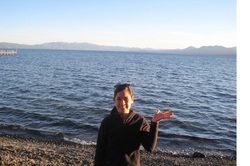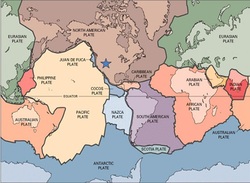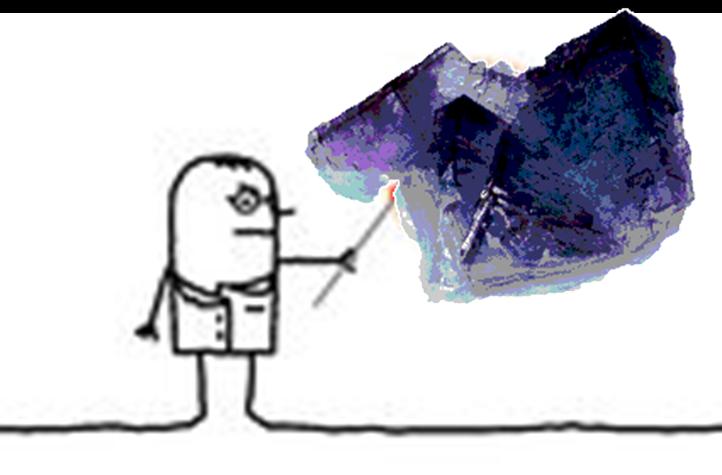Need a density review? http://www.middleschoolchemistry.com/lessonplans/chapter3/lesson2
In order to decide is an substance is a mineral, you should SNIFC it! Is the substance... Solid? Naturally occurring? Inorganic? Does it... have a definite chemical Formula? have a Crystalline structure? Here is a great website to quiz yourself on minerals: http://www.oum.ox.ac.uk/thezone/minerals/define/quiz/index.htm
 Hi 7th Grade! Hope you enjoyed your long weekend. I went for a ski trip to Lake Tahoe. It is located right on the border between Nevada and California. I was so excited to see so many things that we've been learning in class. Please take a look at the following photos and details about the Lake Tahoe region to see if you can figure our what formed this area. -Ms. Lopez  Lake Tahoe is high up in the Sierra Nevada mountain range  I found volcanic rock everywhere!  The star is around where the Sierra Nevadas are located on a plate boundary map. Your Task:
1. Brainstorm any other questions you would like to ask me about the area 2. Compile a list of the evidence 3. Answer the following questions in a paragraph: What boundary formed the region known as the Sierra Nevadas, when and how do you know? Use the following checklist to make sure you are ready to present! PowerPoint Checklist Key points for each slide - Note form - Clear, easy to understand - Not plagiarized Title for each slide - Specific title - Appropriate, professional title Visual for each slide - Supports text - Is cited Title page with names and date and visual Works cited page with websites used for information Formatting (font, color, animation) does not distract from presentation Knowledgeable presenters can explain bullets (not just read), explain visuals, speak clearly with eye contact Today you should work on wrapping up your project. Once you are done with all text and all visuals, you may focus on formatting (font, colors, background, animation).
Near the end of class we will go over the rubric that I will use to grade your presentations. Hope you had a great weekend! Hopefully you finished the majority of your text yesterday. If not, make sure you finish that today before you move on. Read a few of the comments that I published on yesterday's blog entry. These will help to remind you to keep your PowerPoint effective and professional. Once you have read the comments, tilt your screen halfway down to signal that you are ready to get a short tutorial on inserting photos with citations into your presentation. P.S. Happy Friday! Enjoy the weekend! Today you will start building your PowerPoint by inserting the titles and the text as you planned on your draft. I will give you a quick overview and refresher of how to use it, but there are also "tips and tricks" in the upper menu bar of this website.
Before creating our PowerPoint drafts, we compared and contrasted two sample slides on the Appalachian Mountains. We then brainstormed a list of what made a slide effective or ineffective as a presenting tool. For your Do Now, leave a sentence (complete with correct spelling and grammar) that explains one thing you should avoid while creating your slides. Once you have answered the Do Now, tilt your laptop screen halfway closed in order to signal that you are ready to see the PowerPoint tutorial. Continue to research your project topic today. Make sure to keep track of citations!
Before you begin, leave one cool fact about your project in the comments below. Make sure that your grammar and spelling are correct! If you are missing scientific information, try going to the following websites and using the search bar to locate your topic: www.usgs.gov www.geology.com If you are missing information on who/what your topic affected, try the following news sites. Use the search bar to locate articles on your topic. www.nytimes.com www.npr.org Here are other helpful websites (search for your topic using the search bar). National Geographic Plate boundary map Use the document entitled "12.15_Research Topics" to guide your research for today. You can find this document in the "Student Drive" in the "Lopez" folder. You are looking to collect information on the following topics:
P.S. You may use Wikipedia as a starting point or as a summary before you begin; however you must do your research using the pages listed. Does anyone have an idea of why Wikipedia might not be the most reliable or helpful source for research? Post your answer in the comments. Today we will be taking virtual field trips to see the effects of plate tectonics in the San Francisco Bay Area. In your group, decide which field trip you would like to go on. Follow the link and the directions. Then, craft a thoughtful paragraph answer to today's classwork. If you have time after the field trip, leave a comment on this blog answering the opinion question: Knowing that the bay area is a very active geologic area (right on a boundary!), would you live there? Sibley Volcanic Regional Preserve: Read the overview, then midway down the page click "Sibley's Round Top: A sideways volcano" and read "Volcanoes in the East Bay? Really?" and "A few volcano basics". Then, on the map, click and read stop# 2, 3, 4, 6. Alum Rock Park: Read the overview, then, midway down the page click "Alum Rock- Spring and Shake" and read the section entitled "Remnants of Volcanic Days" . Then, on the map, click and read stops #2 and 4. Mt. Diablo State Park: Read the overview, then, midway down the page click "Mt.Diablo: an upside-down trek through time" and read the section entitled "The ground's all turned around" and "2 million years ago". Then, on the map, clock and read stops #3 and 5. Los Trancos Open Space Preserve Read the overview, then, midway down the page click "Plate Tectonics" and read the sections entitled "Plate Tectonics" and "Earthquakes are a snap". In the map, read stops #1 and 4. If you have time, read "Measuring Plate Movement". |


 RSS Feed
RSS Feed